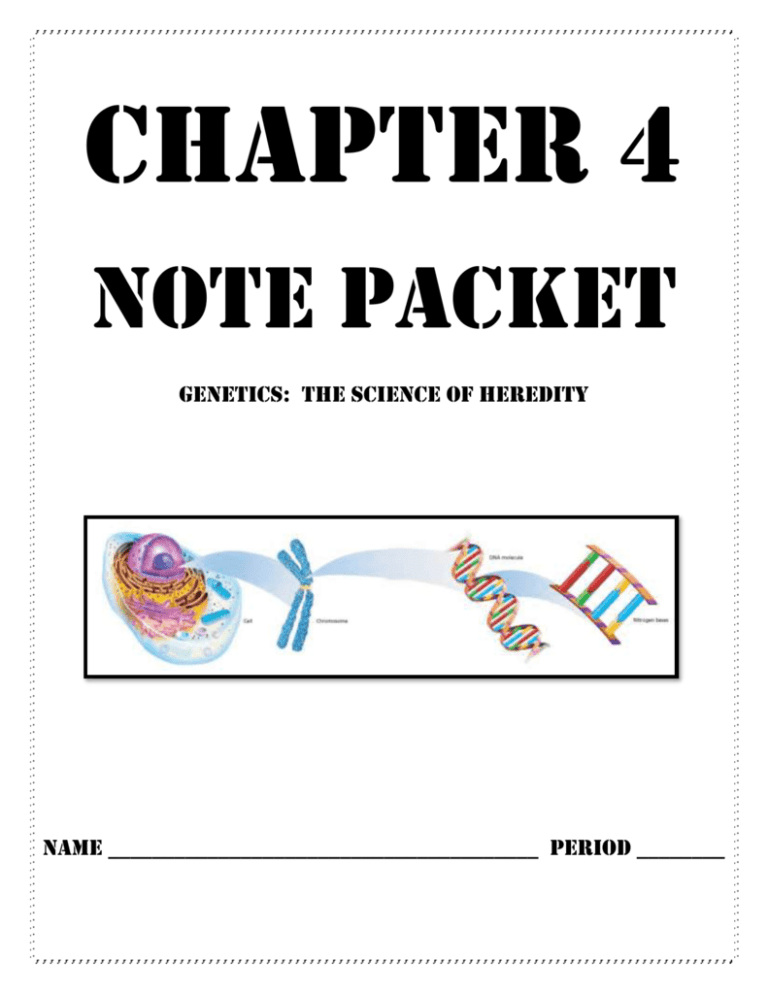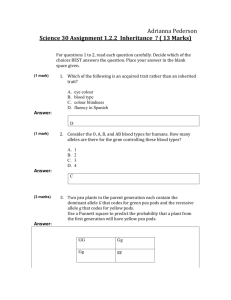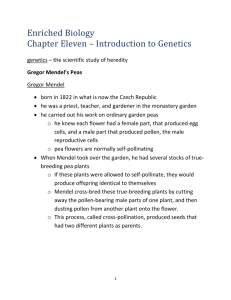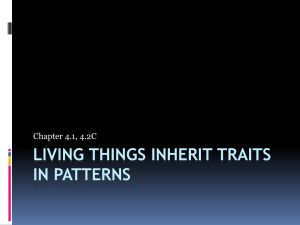Ch 4 Note Packet
advertisement

CHAPTER 4 NOTE PACKET Genetics: the science of heredity NAME _______________________________________ Period ________ Chapter 4 SECTION 1: MENdEl’S WOrk Gregor Mendel _________________________________________________________________________________________________________________ __________________________________ named Gregor Mendel Worked in a garden at a ____________________________________________ Heredity: ____________________________________________________________________________________________________ Why do pea plants have different characteristics? Traits: __________________________________________________________________________ o Examples: ____________________ (tall or short), ________________________ (green or yellow) Pea plant TRAITS were often ________________________________ to those of their parents and sometimes they were _______________________________________. His studies laid the foundation for __________________________________– the scientific study of heredity Mendel’s Experiments The flower’s petals surround the _______________________ and the ______________________________. Pistil: _________________________________________________________________________________________________________ _____________________________________: produce pollen, which contains male sex cells, or sperm Fertilization: _________________________________________________________________________________________________ Self-Pollinating Pea plants are usually ____________________________________________________ Pollen from a flower lands on a pistil of the same flower Cross-Pollinating “___________________________” Mendel removed _____________________________ from a flower on one plant, then ______________________________________ onto a flower on a second plant. Crossing Pea Plants How are you going to study the inheritance of traits in pea plants? Mendel decided to “cross” plants with ____________________________________________________________________ o Example: ______________________________________________________________________ He started with purebred plants Purebred: ____________________________________________________________________________________________________ The F1 and F2 Offspring 1. Mendel crossed ____________________________________ tall plants with purebred _________________ plants a. This is called parental generation, or the ___________________________________________ 2. _____________________________________________ are all tall a. The offspring from this cross are the first filial generation, or the __________________________________________ 3. He then allowed for the F1 offspring to _________________________________________________ 4. F2 offspring are tall and short a. The offspring from this cross are the second filial generation, or the ________________________________________________ What other traits did Mendel study? ______________________________________________________________________ ________________________________________________________________________________________________________________ What were the two forms of the seed shape? _____________________________________________________________ _________________________________________________________________________________________________________________ Genes and Alleles ____________________________: factors that control a trait Alleles: _______________________________________________________________________________ An organism’s traits are controlled by alleles it inherits from its parents. Some alleles are dominant, while others are recessive Dominant Alleles vs. Recessive Alleles __________________________________________: an allele whose trait always shows up in the organism when the allele is present Recessive Allele: _____________________________________________________________________________________________ Let’s do some math….Examples for Stem Height One recessive allele + one dominant allele = ______________________________________________________________ One recessive allele + one recessive allele = _______________________________________________________________ Alleles in Mendel’s Crosses Combination of Alleles: Hybrid tall: ___________________________________________________________________________________________________ __________________________________: two alleles for tall stems __________________________________: two alleles for short stems Symbols for Alleles Geneticists use letters to represent alleles Dominant allele is represented by a ________________________________________ o Example: tall stems = _____________ Recessive allele is represented by a _______________________________________ o Example: short stems = _________________ PRACTICE PROBLEMS: 2 dominant alleles for tall stems = 2 recessive alleles for short stems = 1 recessive allele for short stems and 1 dominant allele for tall stems = Significance of Mendel’s Contribution The importance of Mendel’s discovery was _________________ recognized during his lifetime Mendel is often called the ______________________________________________________ Chapter 4 Section 2: Probability and Heredity Principles of Probability Probability: _________________________________________________________________________________________________ Coin toss: ____________________________________________________________________________________________________ o 1 in 2 chance, ½, 50% The Laws of Probability predict what is ______________________________ to occur Independence of Events When you toss a coin more than once, _____________________________________________________________________ _________________________________________________________________________________________________________________ Principles of Probability with Genetics _________________________________________________________________________________________________________________ _________________________________________________________________________________________________________________ He could say that the probability of producing… o A tall plant was _______________________ o A short plant was _______________________ Punnett Squares Punnett square: _________________________________________________________________________________________ _____________________________________________________________________________________________________________ They show all the possible outcomes of a genetic cross and determine the ______________________________ of that outcome Example Hybrid: _____________________________________________________________________________________ o R: _____________________________________________________ o r: _____________________________________________________ Using a Punnett Square Use a Punnett square to calculate the _______________________________________________ In a genetic cross, ____________________________________________________________________________________________ Punnett Square and Probability Problems What is the probability that the offspring will be RR? What is the probability that the offspring will be rr? What is the probability that the offspring will be Rr? What is the probability that the offspring will be a round seed? What is the probability that the offspring will be a wrinkled seed? Predicting Probabilities Dominant: ______________________________ Recessive: ______________________________ What are the possible allele combinations? What is the probability the guinea pig has black fur? Phenotypes and Genotypes Phenotype: ___________________________________________________________________________________________________ Genotype: ____________________________________________________________________________________________________ Homozygous and Heterozygous Purebred = _____________________________________________ = ______________________________________________ SS or ss Hybrid = ________________________________________________ = ______________________________________________ Ss Codominance Codominance: _______________________________________________________________________________________________________ Chapter 4 Section 3: The Cell and Inheritance What structures in cells contained genes? “The Clue in the Grasshopper’s Cells” Walter Sutton, an American _____________________________________ who studied the cells of grasshoppers Wanted to know how _______________________________ form (sperm and egg) ___________________________________________ are they key to understanding how offspring have traits similar to those of their parents Chromosomes in a Grasshopper… _______________________________________ of grasshoppers have __________ chromosomes Sutton found that the grasshopper’s _______________________________________________________________________ Grasshopper’s sex cells ______________________________________________________________________________________ _________________________________________________________________________________________________________________ Chromosome Pairs When a sperm cell and an egg cell __________________________________________________________________________ _________________________________________________________________________________________________________________ The grasshopper offspring had ________________________ number of chromosomes in its cells as did each of its _______________________________________ Genes on Chromosomes Alleles: ________________________________________________________________________________________________________ Ex: __________________________________________ One allele in a pair comes from ______________________, one allele comes from ____________________________ Chromosome Theory of Inheritance _________________________________________________________________________________________________________________ _________________________________________________________________________________________________________________ How do sex cells end up with half the number of chromosomes as body cells? __________________________ o The process by which the number of chromosomes is reduced by ______________ to form sex cells– sperm and eggs What happens during meiosis? Refer to pg. 128-129 Before Meiosis _________________________________________________________________________________________________________________ Meiosis I A: _____________________________________________________________________________________________________________ B: The pairs ______________________________ and __________________________________to opposite ends of the cell C: __________________________________ form, each with _______________________the number of chromosomes Meiosis II A: _____________________________________________________________________________________________________________ B: The ___________________________________________________ and move to opposite ends of the cell End of Meiosis __________________ sex cells form with half the number of chromosomes as the parental cells Meiosis and Punnett Squares _______________________________________ is actually a way to show the events that occur in _________________ ____________________ allele from each pair goes to each _____________________________ (sperm and egg) A Lineup of Genes The body cells in humans contain ___________________________________________________ (or _________chromosomes) Chromosomes ________________________________________________________________________________________________ _________________________________________________________________________________________________________________ Although you have only 23 pairs of chromosomes, _______________________________________________________ _________________________________________________________________________________________________________________ Each gene controls a trait. Genes on Chromosomes (Refer to pg. 130) Genes are located _______________ chromosomes For which genes is this organism homozygous? For which genes is it heterozygous? Chapter 4 Section 4: The DNA Connection The Genetic Code The main function of a gene is _________________________________________________________________________________ ____________________________________________________________________________________________________________________ Proteins help determine the _________________________________________________________________ of an organism. Genes and DNA Chromosomes are composed mostly of __________________________ Review: DNA is made up of _____________________different nitrogen bases… o ____________________________________________________________________________________________________________ A gene ____________________________________________________________________________________________________________ ____________________________________________________________________________________________________________________ A gene is made up of a series of ____________________ in a row The bases on a _________________________ are arranged in a __________________________________________________ Order of the Bases The order of the nitrogen bases along a gene _____________________________________________________________ _________________________________________________________________________________________________________________ Proteins: long-chain molecules made of ___________________________________________________________________ A group of ___________________ DNA bases codes for one specific _____________________________________ How Cells Make Proteins Protein synthesis: ____________________________________________________________________________________ During protein synthesis, the cell uses information from a ___________________________on a chromosome to produce a specific ______________________________. Where? ______________________________________________________________________________________________________ The Role of RNA _________________________________________________________________________________________________________________ _________________________________________________________________________________________________________________ The genetic “messenger” is called _________________________________________________________, or RNA RNA and DNA differ in some important ways… o RNA only has ____________________ strand o ________________________________________________________ molecule o RNA contains _________________________ instead of thymine Types of RNA Messenger RNA (mRNA): copies the coded message from the _______________ in the nucleus, and _______________________ the message from the ribosome in the cytoplasm. Transfer RNA (tRNA): carries ______________________ ______________________ to the ribosomes and adds them to the ____________________________ _____________________________ Mutations Mutations: ____________________________________________________________________________________________________ Can cause a cell to produce an incorrect __________________________________ during protein synthesis The _________________________________, or phenotype may be different from what it normally would have been o Body cell – the mutation will _______________ passed to offspring o Sex cell –the mutation _________________ ______________ passed to an offspring and affect the offspring phenotype Type of Mutations Substitution: ____________________________________________________________________________ Deletion: ________________________________________________________________________________ Addition: ________________________________________________________________________________ Effects of Mutations Can be a source of _________________________________________________________________ Some mutations are ____________________________________, other mutations are ____________________________________ A mutation is harmful if it ___________________________________________________________________________________ _________________________________________________________________________________________________________________ White lemurs living in the wild? ___________________________________ Antibiotic resistance in bacteria? ___________________________________ A mutation that is harmful or helpful depends partly on its ___________________________________________.








